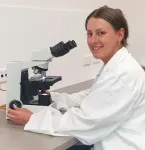(Press-News.org) Key takeaways
Astrophysicists have found that a large exoplanet known as WASP-69b is being trailed by a tail of gas seven times as long as the planet itself.
The comet-like tail is the result of the planet’s gas atmosphere being burned off as it passes precariously close to the hot star it orbits and stretched by stellar winds.
By studying this process in real time, scientists can better understand how thousands of other planets in our galaxy have evolved.
WASP-69b is having a hot girl summer that never ends. The huge gaseous exoplanet, roughly the size of Jupiter and approximately 160 light years from Earth, orbits its searing host star so closely that its atmosphere is boiling away at a rate of 200,000 tons per second.
In new research published in The Astrophysical Journal, a team led by UCLA astrophysicists discovered that as the planet’s atmosphere escapes into space, its host star’s stellar winds sculpt it into a comet-like tail that trails the planet for at least 350,000 miles — far longer than observed before.
“Work by previous groups showed that this planet was losing some of its atmosphere and suggested a subtle tail or perhaps none at all,” said Dakotah Tyler, a UCLA doctoral student and first author of the research. “However, we have now definitively detected this tail and shown it to be at least seven times longer than the planet itself.”
Discovered a decade ago, WASP-69b is known as a “hot Jupiter” — a gas giant planet that orbits precariously close to its star. In fact, the exoplanet is so close that it completes a full orbit in less than four Earth days; by comparison, Mercury, the closest planet to our sun, has an 88-day orbit.
The discovery that WASP-69b’s star is not only stripping away the planet’s atmosphere with high-energy radiation but also physically shepherding that escaped gas into a long, thin tail helps to reveal how stellar winds affect planets that orbit their stars so closely. Studying this type of atmospheric mass-loss directly is pivotal for understanding exactly how planets across the galaxy evolve over time with their stars, the researchers said.
“Over the last decade, we have learned that the majority of stars host a planet that orbits them closer than Mercury orbits our sun and that the erosion of their atmospheres plays a key role in explaining the types of planets we see today,” said co-author and UCLA professor of physics and astronomy Erik Petigura. “However, for most known exoplanets, we suspect that the period of atmospheric loss concluded long ago. The WASP-69b system is a gem because we have a rare opportunity to study atmospheric mass-loss in real time and understand the critical physics that shape thousands of other planets.”
Earlier observations of WASP-69b, conducted with a 3.5-meter telescope at the Calar Alto Observatory in Spain and a 5-meter telescope at the Palomar Observatory in San Diego County, showed only a hint of a tail or no tail. For the current study, the researchers used a larger, 10-meter telescope at the W. M. Keck Observatory in Hawaii, along with its high-resolution spectrograph instrument, called NIRSPEC, to make observations that were more sensitive to the detailed structure of WASP-69b’s escaping atmosphere.
The observations revealed that WASP-69b’s escaping gas, primarily hydrogen and helium, is shaped and pushed in the direction of Earth by radiation and an outflow of gas from its host star known as a stellar wind for hundreds of thousands of miles. The researchers were then able to calculate the amount of mass the planet was losing.
“These comet-like tails are really valuable because they form when the escaping atmosphere of the planet rams into the stellar wind, which causes the gas to be swept back,” Petigura said. “Observing such an extended tail allows us to study these interactions in great detail.”
Even though the hot Jupiter is dancing a dangerous tango with its star, Tyler said its atmosphere won’t completely evaporate.
“At around 90 times the mass of Earth, WASP-69b has such a large reservoir of material that even losing this enormous amount of mass won’t affect it much over the course of its life. It’s in no danger of losing its entire atmosphere within the star’s lifetime,” Tyler said.
“The resilience of this planet in such an extreme and hostile environment serves as a powerful reminder to us all,” he added. “Despite the multitude of challenges we may face, our capacity to withstand and overcome is often far greater than we realize. Our problems may seem daunting, but like WASP-69b, we have what it takes to continue on.”
Other authors of the paper include Antonija Oklopcic from the University of Amsterdam and Trevor David from the Flatiron Institute.
END
A Jupiter-sized planet has been hiding a big secret: A 350,000-mile-long tail
Scientists say the discovery presents a rare opportunity to study the physics that shape thousands of other planets
2024-01-09
ELSE PRESS RELEASES FROM THIS DATE:
How black silicon, a prized material used in solar cells, gets its dark, rough edge
2024-01-09
Researchers at the U.S. Department of Energy’s Princeton Plasma Physics Laboratory (PPPL) have developed a new theoretical model explaining one way to make black silicon, an important material used in solar cells, light sensors, antibacterial surfaces and many other applications.
Black silicon is made when the surface of regular silicon is etched to produce tiny nanoscale pits on the surface. These pits change the color of the silicon from gray to black and, critically, trap more light, an essential feature of efficient solar cells.
While there are many ways to make black silicon, including some that use the ...
The secret to better rural healthcare: Pay doctors to travel from urban to rural areas
2024-01-09
Researchers from University of Oxford, Arizona State University, and University of Iowa published a new Journal of Marketing study that examines how paying doctors to visit rural areas is a cost-effective way to provide reasonable access and effective care to most rural communities.
The study, forthcoming in the Journal of Marketing, is titled “Bringing the Doctor to the Patients: Cardiology Outreach to Rural Areas” and is authored by J. Jason Bell, Sanghak Lee, and Thomas S. Gruca.
Rural health care is in crisis.
Between 2010 and 2015, the death rate from coronary heart disease was significantly ...
Different pain types in multiple sclerosis can cause difficulty staying active
2024-01-09
For patients with multiple sclerosis, a regular exercise routine is important for managing symptoms. Due to different causes of chronic pain though, physical exercise can be more difficult for some.
Research published in the Journal of Pain from the University of Michigan found that widespread pain with nociplastic features, also known as WPNF, can make engaging in physical activity a painful task for some patients with MS.
“WPNF is a chronic and diffuse pain which can be challenging ...
The Frank R. Breul Memorial Prize
2024-01-09
We are pleased to announce that the 2024 Frank R. Breul Memorial Prize has been awarded to Jessica Pac, Sophie Collyer, Lawrence Berger, Kirk O'Brien, Elizabeth Parker, Peter Pecora, Whitney Rostad, Jane Waldfogel, and Christopher Wimer for their article “The Effects of Child Poverty Reductions on Child Protective Services Involvement,” which appears in the March 2023 issue. The prize pays tribute to Professor Breul’s career as an educator, administrator, and editor of the Social Service Review (SSR) while on the faculty of the Crown Family School of Social Work, Policy, and Practice at the ...
New findings reveal koalas’ health risks following bushfires, will aid in future rescue efforts
2024-01-09
DENVER/Jan. 9, 2023 – A new scientific publication featured in Veterinary Sciences will guide future wildlife rescue and rehabilitation after Australian bushfires. These findings provide critical information for improving koala care during subsequent fire seasons.
Natasha Speight, a Senior Lecturer at the University of Adelaide’s School of Animal and Veterinary Sciences, spearheaded the study, analyzing clinical data from koalas affected by the recent Australian bushfires. Beyond generalized skin burns, the study revealed severe footpad burns, hindering koalas’ tree-climbing abilities and escape from fires. The study ...
Virginia Tech, Virginia Cooperative Extension receive USDA funding to advance specialty crops
2024-01-09
Six Virginia Tech and Virginia Cooperative Extension projects that help advance the competitiveness of specialty crops grown in the commonwealth have been awarded nearly $550,000 through the U.S. Department of Agriculture (USDA)’s Specialty Crop Block Grants program. The projects are aimed at assisting Virginia farmers in making specialty crop production a driver of economic development.
Specialty crops are defined as fruits and vegetables, tree nuts, dried fruits, and horticulture and nursery crops, including floriculture. Virginia Tech and Extension’s projects ...
Voice recognition project recruiting adults with cerebral palsy
2024-01-09
The Speech Accessibility Project is now recruiting U.S. and Puerto Rican adults with cerebral palsy.
Those interested can sign up online.
Funded by Big Tech companies Amazon, Apple, Google, Meta, and Microsoft, the University of Illinois Urbana-Champaign aims to train voice recognition technologies to understand people with diverse speech patterns and disabilities. The project began recruiting people with Parkinson’s disease last spring, those with Down syndrome last fall, and more recently, those with amyotrophic lateral sclerosis. The project will also recruit people who have had a stroke.
Researchers at UIUC’s Beckman Institute for Advanced ...
Journal of Alzheimer’s Disease welcomes new co-editor-in-chief Paula I. Moreira, PhD
2024-01-09
Amsterdam, January 9, 2024 – The Journal of Alzheimer’s Disease (JAD), published by IOS Press, is pleased to announce the appointment of new co-Editor-in-Chief, Paula I. Moreira, PhD. Dr. Moreira joins Editor-in-Chief George Perry, PhD, and an eminent international editorial board who are dedicated to the continuing success of the world’s leading journal in Alzheimer’s research and treatment.
Dr. Moreira is an Associate Professor of Physiology at the Faculty of Medicine, University of Coimbra and leads the MitoBD (Mitochondria in Brain Disorders) research group at the Center ...
DOE’s Office of Science supports 173 outstanding undergraduate students and 8 faculty members from institutions underrepresented in the scientific research enterprise
2024-01-09
WASHINGTON, D.C. – The U.S. Department of Energy’s (DOE’s) Office of Science will sponsor the participation of 173 undergraduate students and eight faculty members in three science, technology, engineering, and mathematics (STEM)-focused workforce development programs at 13 DOE national laboratories and facilities this spring. Collectively, these programs ensure that both DOE and communities across the nation have a strong, sustained workforce trained in the skills needed to address the energy, environment, and national ...
With only the pawprints, researchers study elusive bobcat
2024-01-09
One Sunday morning in February of 2021, Dave Duffy’s kids told him they had just seen a bobcat through the window of their home near the University of Florida’s Whitney Laboratory for Marine Bioscience outside St. Augustine, Florida. They knew their dad would want to know, because they had helped him countless times take samples of animal tracks in hopes of studying the creatures that left them.
Initially skeptical – bobcats are rarely spotted during the day out in the open – Duffy eventually went to check and there they were: six clear bobcat prints in the sandy soil. With his kids’ help, he scooped up small soil samples from the ...
LAST 30 PRESS RELEASES:
Your pet's flea treatment could be destroying the planet
Diabetes risk not associated with timing or type of menopause
Bulk inorganic crystals grown from water emit “handed” light
A new AI-based attack framework advances multi-agent reinforcement learning by amplifying vulnerability and bypassing defenses
While exploring the cosmos, astronauts also fuel explorations of the biology of aging and cellular resilience
Design and synthesis of Zr-IR825 nanoparticles for photothermal therapy of tumor cells
Food critics or food grabbers? When choosing food, wood mice split into careful examiners who sniff and handle, and quick nut grabbers
‘Cosmic clock’ reveals Australian landscapes’ history and potential future
Higher maternal blood pressure increases the risk of pregnancy complications, study concludes
Postoperative complications of medical tourism may cost NHS up to £20,000/patient
Phone apps nearly 3 times as good as no/basic support for quitting smoking long term
Female sex and higher education linked to escalating prevalence of obesity and overweight in Africa
THE LANCET + eCLINICALMEDICINE: Two studies on reductions in mortality from small changes lifestyle changes
AI model identifies how every country can improve its cancer outcomes
Young people risk drifting into serious online offenses through a slippery slope of high-risk digital behavior
Implant provides lasting relief for treatment-resistant depression
Autologous T cell therapy targeting multiple antigens shows promise treating pancreatic cancer
First extensive study into marsupial gut microbiomes reveals new microbial species and antimicrobial resistance
Study debunks myth of native Hawaiians causing bird extinctions
Tailored biochar could transform how crops grow, resist disease, and clean polluted soils
Biochar-based enzyme technology offers new path for cleaner water and soil
Biochar helps farmland soils withstand extreme rain and drought by steadying carbon loss
New study reveals major gaps in global forest maps
Ochsner Health names Dr. Timothy Riddell executive vice president and chief operating officer
Can future-focused thoughts help smokers quit?
From brain scans to alloys: Teaching AI to make sense of complex research data
Stem Cell Reports seeks early career editors to join the editorial board
Signs of ancient life turn up in an unexpected place
Pennington Biomedical researchers explore factors behind body’s ability to regulate weight
Zhongping Lee awarded the Nils Gunnar Jerlov Medal
[Press-News.org] A Jupiter-sized planet has been hiding a big secret: A 350,000-mile-long tailScientists say the discovery presents a rare opportunity to study the physics that shape thousands of other planets



